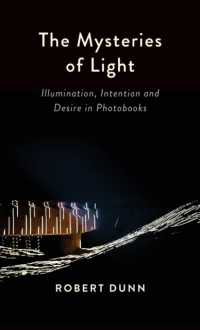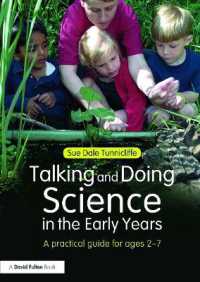Full Description
This book is a study of 'collecting' undertaken by Joseph Antoine Bruni d'Entrecasteaux and his shipmates in Tasmania, the western Pacific Islands, and Indonesia. In 1791-1794 Bruni d'Entrecasteaux led a French naval expedition in search of the lost vessels of La Pérouse which had last been seen by Europeans at Botany Bay in March 1788. After Bruni d'Entrecasteaux died near the end of the voyage and the expedition collapsed in political disarray in Java, its collections and records were subsequently scattered or lost.
The book's core is a richly illustrated examination, analysis, and catalogue of a large array of ethnographic objects collected during the voyage, later dispersed, and recently identified in museums in France, Norway, the Netherlands, Switzerland, and the United States. The focus on artefacts is informed by a broad conception of collecting as grounded in encounters or exchanges with Indigenous protagonists and also as materialized in other genres—written accounts, vocabularies, and visual representations (drawings, engravings, and maps).
Historically, the book outlines the antecedents, occurrences, and aftermath of the voyage, including its location within the classic era of European scientific voyaging (1766-1840) and within contemporary colonial networks. Particular chapters trace the ambiguous histories of the extant collections. Ethnographically, contributors are alert to local settings, relationships, practices, and values; to Indigenous uses and significance of objects; to the reciprocal, dialogic nature of collecting; to local agency or innovation in exchanges; and to present implications of objects and their histories, especially for modern scholars and artists, both Indigenous and non-Indigenous.
Contents
Abbreviations
Preface and Acknowledgements
PART I: PROLOGUE
1 History — Contexts, Voyage, People, Collections - Bronwen Douglas Feature: The 'Effets' (effects) plates - Bronwen Douglas
2 Ethnohistory — Collecting and Representing - Bronwen Douglas
PART II: ARTEFACT COLLECTIONS
3 Object Trajectories, Webs of Relationships - Fanny Wonu Veys
4 Musée du Quai Branly - Jacques Chirac, Paris - Bronwen Douglas Feature: bwar — Kanak hache-ostensoir, ceremonial axe - Bronwen Douglas Feature: sisi fale — Tongan coconut fibre waist garment - Billie Lythberg and Melenaite Taumoefolau
5 Musée des Beaux-Arts, Dunkerque - Claude Steen-Guélen and Hélène Guiot Feature: kie — Tongan small fine mat - Hélène Guiot
6 Universitetsmuseet, Bergen - Knut Rio Feature: Encountering Māori and their artefacts - Billie Lythberg and Mānuka Hēnare Feature Archery equipment - Andy Mills
7 Kulturhistorisk Museum, University of Oslo - Arne Aleksej Perminow
8 Museum Volkenkunde - Nationaal Museum van Wereldculturen, Leiden - Fanny Wonu Veys Feature Tongan ships carving Fanny Wonu Veys Feature helu tu'u — Tongan comb and hair dressing - Billie Lythberg and Melenaite Taumoefolau
9 Tropenmuseum - Nationaal Museum van Wereldculturen, Leiden - Tristan Mostert
10 Zeeuws Museum, Middelburg - Caroline van Santen
11 Peabody Museum of Archaeology and Ethnology at Harvard University, Cambridge, MA - Fanny Wonu Veys Feature kali — Tongan headrests - Fanny Wonu Veys
12 Musée cantonal d'Archéologie et d'Histoire, Lausanne - Claire Brizon, Claude Leuba, and Lionel Pernet with Fanny Wonu Veys and Bronwen Douglas Feature Absent objects, Muséum d'Histoire naturelle du Havre - Thierry Vincent
PART III: OTHER COLLECTIONS
13 Drawings and Engravings - Bronwen Douglas Feature tayenebe, exchange — Reviving Aboriginal fibre work in Tasmania - Julie Gough Feature kupesi — Tongan design structure and Piron's experiment - Billie Lythberg and Semisi Fetokai Potauaine
14 Tongan Wordlists - Paul Geraghty 15 Tongan Musical Instruments - Fanny Wonu Veys, Billie Lythberg, and Rachel Hand with Tavake-fai-'ana Semisi Fetokai Potauaine
PART IV: RE-INTERPRETATIONS AND TRANSFORMATIONS
16 Cultural Currents — Tongan and Fijian Sculpture - Andy Mills
17 Tongans in 1793 Phyllis Herda and Bronwen Douglas
18 Translation and Transformation — Piron's Drawings - Nicola Dickson Feature Lisa Reihana's Emissaries - Billie Lythberg
PART V: EPILOGUE
19 Reflections Nicholas Thomas
PART VI: CATALOGUE
Appendix 1 Catalogue of the objects - Fanny Wonu Veys, Billie Lythberg, and Andy Mills Appendix
2 List of Objects by Institution - Fanny Wonu Veys and Billie Lythberg Appendix
3 List of Objects by Provenance - Fanny Wonu Veys and Bronwen Douglas Contributors Figures References Index








